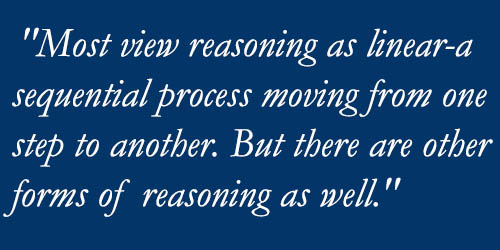Reasoning is a process that seeks to arrive at correct conclusions. Most view reasoning as linear—a sequential process moving from one step to another. But there are other forms of reasoning as well.
Triangular Reasoning. Think of a triangle. Its wide base, which progressively narrows, supports a singular point. A thought process that winnows out the unnecessary or irrelevant to reach an optimal end is reflective of such a structure. So too is a thought process that seeks to derive a single general principle from distinct and disparate elements.
Rectilinear reasoning. Think of a rectangle. Its corners are aligned and its opposing sides are the same length. A thought process that weighs and balances competing arguments is reflective of such a structure. So too is a thought process that starts out with primary or uncontradicted premises—or phrased differently, a rectangle on its side is more stable than one balanced on one of its corners.
Spherical reasoning. Think of a sphere. It perfectly encloses that which is contained within. It has the shape of a cell, a water droplet—or the earth. A thought process that encompasses and reconciles opposing ideas is reflective of such a structure. So too is a thought process that encapsulates and resolves all potential results and consequences, both optimal and non-optimal.
Winnowing, weighing, and resolving—any nontrivial decision has to implicate all three. And it’s easy to anticipate the results that will occur when a decision-maker skips a step. For example, if inadequate investigation or research is not first undertaken, the shape of the triangle will suffer. If opposing arguments are not first considered, the shape of the rectangle will be affected. If an attempt to resolve opposing ideas is not first made, the shape of the sphere will be harmed.
What if these are abandoned? Are conclusions reached that ignore these steps equally as reliable? In some cases, but in many instances the correct decision is not obvious—and that’s where a more highly-structured approach may yield unexpected benefits.
For example, a common problem is whether to forgo a short-term gain in anticipation of later obtaining an even greater long-term benefit. Such problems are multi-faceted, and a highly-structured method provides a more coherent framework to address each aspect—values such as the probable cost of delay as compared to the probable increased value achieved by waiting can be more accurately assessed and weighed.
But even highly-structured reasoning may not always lead to a correct result. The role of chance—of unforseen circumstances beyond one’s control—can work to upset even the most closely-guarded path of reasoning. This is not to disparage the value of reasoning, but merely to suggest its outer limit may not always be easily recognized.




